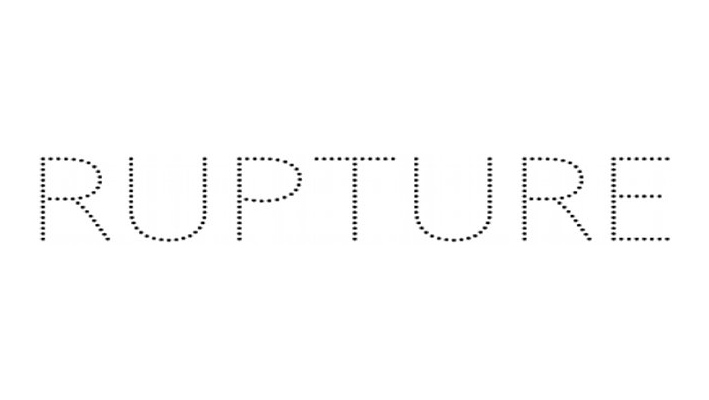Jennifer Hickey & Magnhild Opdøl: Rupture

Opening Reception Saturday 19 November, 4 – 6pm
Curated by Rowan Sexton
A rupture can be described as the state of breaking apart, or alternatively as a breach or disturbance of a harmonious or peaceful situation. These meanings can be attributed to the works on display in the exhibition. When the viewer becomes aware of the rupture between the aesthetic sensibilities of the work, the thematic and symbolic meanings become absolute. Ideological conditions of existential issues and societal change can develop from the discovery of truth and transformation. Gaston Bachelard introduced this philosophical concept, and in The Poetics of Reverie, stated “The subconscious is ceaselessly murmuring, and it is by listening to these murmurs that one hears the truth.” Rupture traces its activity through matters concerned with being and knowing, life and death, the relationship between content and form, and the processes of production. Each piece explores relationships between man, nature and spirit, while refecting on uncontrollable forces at work. Diferent notions of time are present in both Jennifer Hickey and Magnhild Opdøl’s work, in a measured and metaphorical capacity. The arduous ritual of making is evident, in the attention to detail realized by both artists, and in the highly focused, laborious processes employed in executing succinct and meticulous pieces.
Central to Jennifer Hickey’s work are themes of fragility, weightlessness, translucency, rhythm and movement.The primacy of perception is a common narrative throughout her work, where an awareness to sense but not to consciously identify occurs, by blurring the boundaries between subliminal states. Primarily using porcelain and bone china, importance resides in the rituals of making, the physical rhythms, and the time and process involved. Repetition is another aspect of Hickey’s practice that allows a diferent kind of consciousness to be expressed through the completed forms. As the pieces progress spatially, they gain in strength and energy from the repetition in their making. The natural properties of porcelain and bone china and the discipline and delicacy demanded by these clays are a necessary component of the fnished pieces. Hickey’s most recent body of work consists of wafer thin parts that are hand sewn together to create larger sculptural forms. These link directly with her interest in the simplicity of the Japanese aesthetic, in particular the relationship between nature and spirit. It is her attempt to express this that drives her practice.
The poetics of the dead is predominantly and eloquently investigated throughout Magnhild Opdøl’s practice. Her upbringing on a farm has been a substantial infuence, as the process of life and death and the cyclical nature of the seasons is ever present, examined in an unemotive, resolved study of the beauty in decay. Using several means to document and explore death, nature and the rural world, she renders exquisite, physiologically exact depictions of specimens through drawing, and taxidermy memento mori of selected birds and animals. Opdøl explores the efects of decomposition, bypassing the grotesque to focus on the beauty of the still objects and what remains after life. Opdøl’s drawings challenge the observers’ perception, by ofering a fractured and restructured reality. By creating an ambiguity that investigates the overlap between representation and abstraction, her work encapsulates a synthesis of information, reality and death. This concern continues in Opdøl’s confgurations in sculptural form. Specimens clearly resemble their natural forms, defying the eternal life that has been bestowed upon each subject. The clean aesthetic of her work belies the underlying darker meanings of the transformative power of death.
There is a juxtaposition between nature and spirit, expressed in diverse ways by both artists. Jennifer Hickey’s wall piece, Pierced, ofers the most direct reference to physical rupture, as the myriad of individual ceramic parts, assembled to make a large disc, begin to dissipate and spill from the main body of the sculpture, giving the impression of a cellular organism disintegrating. This beautifully rendered deterioration appears as though the life spirit is gradually fltering out of the corrupted structure, leaving the host as a void. Magnhild Opdøl features a selection of works about birds and animals, manifested in drawing and sculpture. In many cultures the bird is recognized as a symbol of the soul or anima, the world’s soul disguised in corporeal form. It’s connection to the sky through fight, linking it to the spiritual symbolism of the divine. Opdøl addresses the dark side of her subjects with grace, humour and compassion, her sculptural piece Narcissus, is the head of a decapitated roe deer on a mirrored plinth. It illustrates the fne line between life and death, depicted in a dream scenario, representative of the story of Narcissus who drowned in his own image. The deer eye looking down into the mirror is closed, not wanting to see himself, suggestive of how some European countries are refusing to look themselves and their own problems in the eye.
Rupture takes place in a contemporary design shop, a non-traditional venue for an exhibition. There is a deliberate strategy to engage with the surrounding environment and the merchandise. By establishing connections between artworks from the interior and exterior of the building, the window is used as a device to look into and see artworks on display. Looking beyond the pieces in the window layout, and examining a further arrangement of work inside, addresses the diferent vantage points from which work can be observed. In the context of its location, by creating a relationship within the main space, the artworks are presented in tandem with design objects, and marginal elements of merchandise will be incorporated as part of the exhibition layout. The artworks negotiate this territory, by examining the location, processes and contextual markers associated with exhibition making. These subtle interventions contribute to the overall experience of engagement with the art.
Text by Rowan Sexton, November 2011.
Jennifer Hickey was born in Dublin and currently lives and works in the city. She graduated from the National College of Art and Design in 2002, and subsequently went to live and work in St.Ives in Cornwall. Following an extended time there, she returned to Dublin to set up a studio. Recent shows include a two-person exhibition with the artist Sonja Landweer at the Peppercanister Gallery Dublin. Her work is currently featured in a touring group exhibition of Irish Contemporary Ceramics in the Millennium Court Arts Centre, Portadown following the inaugural exhibition at Farmleigh Gallery, Dublin. She is included in the State Art Collection of Ireland (OPW) and is in numerous national and international private collections.
Magnhild Opdøl was born in Norway, and is now living and working in Ireland. Since graduating from the National College of Art and Design with and MFA in 2007, she has been widely exhibited both in Ireland and internationally. She was awarded the 2011 Tony O’Malley Residency in Callan, Co. Kilkenny and most recent exhibitions include Galway Arts Centre and Molde Arts Centre, Norway, 2011, alongside FUTURES 10, Royal Hibernian Academy, Dublin, Draíocht Arts Centre and Droichead Arts Centre in 2010. Upcoming solo shows include KUBE Art Museum, Haugesund Kunstforening and Tegnerforbundet, Oslo, Norway in 2012-2013. Her work is included in many public and private collections.
Rowan Sexton is a curator based in Dublin. She is currently working in the Rubicon Gallery. She has previously worked in IMMA, the National Gallery and the Hugh Lane.
1 - 2 Exchange Street Upper
Temple Bar, Dublin 2
